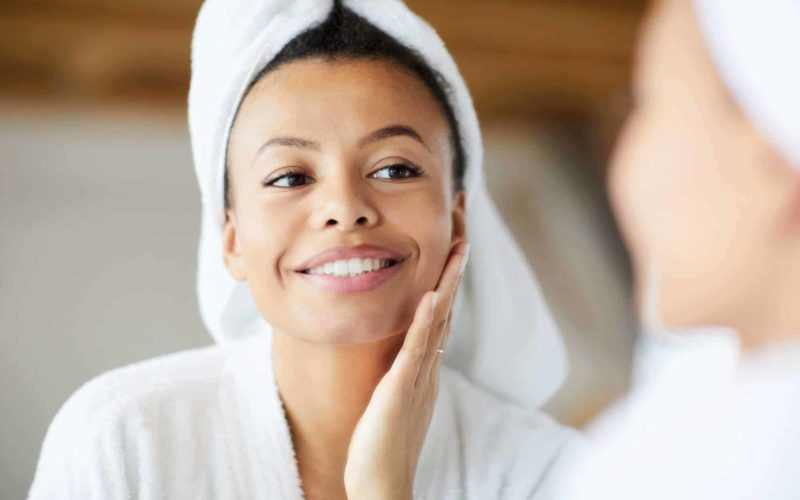Medically Reviewed by Dr. Lisa Hartford, MD
It returns to its original form when we pull or gently tap our skin. It’s possible due to the presence of elastin in the skin. Elastin is a crucial component that offers stretch and recoil to the skin. They are present to add structure, function, flexibility, and youthfulness to the skin.
However, with age, the levels of elastin, collagen, and hyaluronic acid decrease in the skin. Other environmental and lifestyle factors also determine the presence and regeneration of these components in the skin. As a result, a cumulative effect leads to the loss of structural integrity and elasticity. Once elastic and wrinkle-free, the skin will be saggy and full of fine lines and wrinkles.
Some ways may help replenish the elastin and collagen, eliminating mild signs of aging. New approaches, such as microcurrent and red LED therapy, may trigger elastin fiber formation in the skin. Before diving into these methods, let’s first learn in detail about skin elasticity.
What Determines Skin Elasticity?
Understanding elastin and collagen may be a bit confusing. However, a straightforward explanation is that collagen pulls the skin together, and elastin gives it the flexibility to retain its shape. Both of these work together to make the skin appear healthy and young.
Various factors determine the natural elasticity of the skin. For instance, the water content in the subcutaneous fat tissue impacts skin elasticity. Any change in the structure of the elastin fibers causes them to rearrange in a way that reduces elasticity.
Decrease in Elastin Due to Aging
As we age, there is a reduction in fibroblast formation and elastin synthesis. The amount of synthesis isn’t enough to repair the extrinsic and intrinsic damage. As a result, this shows up as saggy skin, wrinkles, and lost elasticity.
Effect of Hormonal Health
The collagen and elastin of the skin are at their prime in the twenties and thirties as the estrogen is at its peak in women. As women age, estrogen decreases due to hormonal changes, leading to thin skin and losing elasticity. This is an intrinsic, inevitable factor that affects elastin.

Around the age of 30-35, the estrogen decline may reduce elastin fibers in the dermal layer. Furthermore, estrogen is at its lowest after 35-45 years of age. Studies have observed it is thirty times lower in postmenopausal women than premenopausal women.
Diet and Lifestyle
If your diet is deficient in antioxidants such as Vitamin E, C, and carotenoids, the body may not be able to make enough elastin. Moreover, lifestyle habits such as smoking and drinking increase the skin aging rate. Consuming a highly processed diet and sugars may also impact the health of your skin.
Photoaging
This is an extrinsic elastin-reducing factor. Unprotected UV exposure over the years leads to skin developing facial wrinkles, fine lines, and age spots. These factors photo age the skin by reducing elastin and collagen in the skin, increasing oxidative stress, and slowing down sun damage repair.
What is Red Light Therapy?
You may wonder what can be done to minimize the effect of the above factors on skin elasticity. Fortunately, with the help of technology, we can balance some of the impacts of using skin treatments proactively. It may not be an overnight change; however, we can counteract some things that lead to rapid skin aging.
Red light therapy is one such treatment that has the ability to penetrate deep inside the dermal tissue. Over the years, studies have been conducted to understand the impact and efficacy of red light for anti-aging and skin rejuvenation.
Red LED Therapy for Elastin Production
Scientists did an experiment focusing on the therapeutic effect of low-level red and infrared lights to study the red light therapy effect on the skin. In the experiment, human dermal fibroblasts were irradiated red and near IR LED lights at 0.5mW/cm square for ten minutes.
Different parameters, such as ATP, collagen, and elastic fibers, were measured using fluorescent and ATP assays. LED therapy was determined to increase the synthesis of type I procollagen, collagen type III, and elastin proteins. In addition, there was significant gene expression of ELN, COL1A1, and LOXL1.

Simply put, an increase in ATP and fibroblast production was also present. All these proteins are food for the skin cells to regenerate and repair. The study concludes that red and infrared light may solve photoaged human skin effectively.
In another study, 136 volunteers participated in a randomized and controlled trial. 113 participants were divided into four treatment groups. They were treated twice weekly with 611–650 and 570–850 nm polychromatic light.
After 30 sessions, data was collected and blindly compared. Different methods were used, such as digital profilometry, collagen density measurement, and patient assessment. These methods used for evaluation resulted in better skin complexion, increased collagen density, and a decrease in fine lines.
Who may benefit from Red LED Therapy?
Since Red light therapy has no side effects, anyone may find it helpful. Moreover, it is non-invasive and has zero downtime compared to fillers or facelifts. Another thing to keep in view is that skin treatments may offer preventative benefits. You may easily prevent wrinkles and fine lines and avoid treating them later in life.
Those with mild wrinkles and fine lines may benefit from collagen and elastin regeneration in the skin. Consistent LED therapy will penetrate the dermis and trigger mitochondria for ATP and fibroblast generation. One significant benefit of red light therapy is that you don’t have to use harsh active ingredients or messy facial lotions.
A word of caution for those treated for seizures or eye disorders may want to skip this therapy and consult a dermatologist about what works best for them.
Using Red LED Therapy for Skin Elasticity
You may go to a professional aesthetician for the treatment. Moreover, some premium professional-grade masks and wands give the same benefit as an at-home treatment.
EvenSkyn Mirage Pro LED Phototherapy Face Mask is a premium at-home LED facial treatment choice. The device has 204 powerful LEDs that offer photobiomodulation with red, blue, and yellow light. You may use red light to promote collagen and elastin. The blue light will reduce acne breakouts, and yellow will rejuvenate skin. These treatments will improve skin laxity, texture appearance, and health.

In just three sessions per week for four weeks, you may notice an improvement in your skin. Before using the mask, clean your skin and find a relaxing place to wind down. Wear the mask for twenty-five minutes for each session to complete the treatment.
Other ways to improve skin elasticity
Diet and supplementation: This may not surprise you, but diet may play a massive role in the health of your skin. Another way to improve your nutrition is to include prescribed supplements such as collagen and vitamins in your diet.
Hyaluronic acid: Any serum or cream with hyaluronic acid may improve your skin’s hydration levels. Therefore, it may help your skin remain elastic.
Radiofrequency treatment: You may get a radiofrequency treatment to increase collagen and elastin in the skin. This will diminish existing fine lines and saggy skin.
Concluding Thoughts
Aging is a natural process; however, we can delay it with proactive measures. Eating well and taking care of your skin are the primary things that determine its appearance. Besides, using red LED treatment to deal with photoaging may lead to a significant decrease in the onset of wrinkles.
Consistency with treatment will help you achieve the glowing, younger, looking skin of your dreams. Also, be patient when using such treatments as the changes occur, and cellular levels may take time to show up. Furthermore, using the appropriate skin care and other treatments alongside LED therapy will show results quicker.
References:
- Leslie Baumann, Eric F Bernstein. “Clinical Relevance of Elastin in the Structure and Function of Skin.” September 2021
- Edwin D Lephart and Frederick Naftolin. “Factors Influencing Skin Aging and the Important Role of Estrogens and Selective Estrogen Receptor Modulators (SERMs).” August 2022
- Wen-Hwa Li, InSeok Seo. “Low-level red plus near infrared lights combination induces expressions of collagen and elastin in human skin in vitro.” June 2021
- Alexander Wunsch and Karsten Matuschka. “A Controlled Trial to Determine the Efficacy of Red and Near-Infrared Light Treatment in Patient Satisfaction, Reduction of Fine Lines, Wrinkles, Skin Roughness, and Intradermal Collagen Density Increase” February 2014
- Flávia Alvim Sant’Anna Addor, Juliana Cotta Vieira. “Improvement of dermal parameters in aged skin after oral use of a nutrient supplement.” April 2018
- Zoe Diana Draelos, Isabel Diaz. “Efficacy Evaluation of a Topical Hyaluronic Acid Serum in Facial Photoaging.” June 2021
- Moetaz El-Domyati, MD, Tarek S. El-Ammawi. “Radiofrequency facial rejuvenation: Evidence-based effect.” March 2011
- Jacob Dunn; Michael H. Grider. “Physiology, Adenosine Triphosphate” February 2023
- Jung-Won Shin, Soon-Hyo Kwon. “Molecular Mechanisms of Dermal Aging and Anti-aging Approaches.” April 2019
- Edwin D Lephart and Frederick Naftolin. “Factors Influencing Skin Aging and the Important Role of Estrogens and Selective Estrogen Receptor Modulators (SERMs).” August 2022









Leave a comment
All comments are moderated before being published.
This site is protected by hCaptcha and the hCaptcha Privacy Policy and Terms of Service apply.